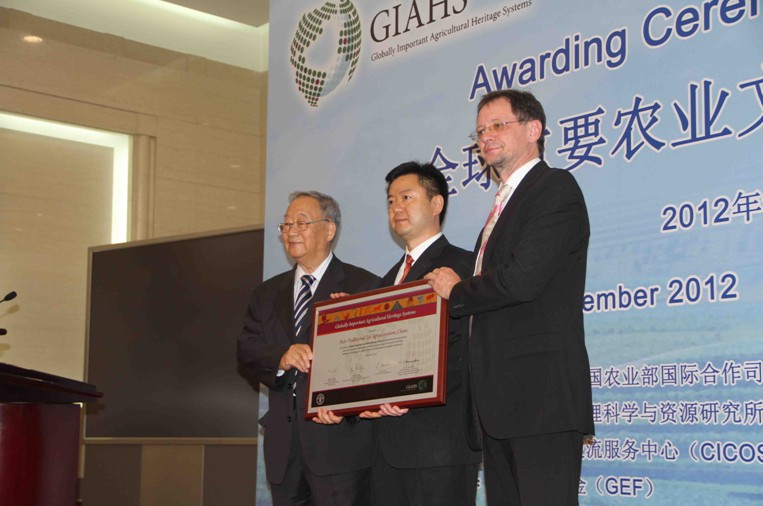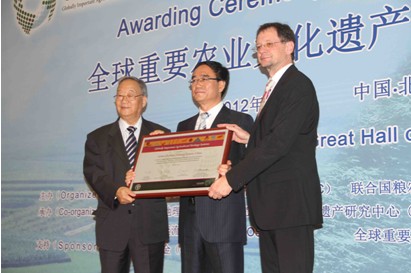Aohan Dryland Farming System and Pu’er Traditional Tea Agroecosystem: Two New FAO GIAHS Pilot Sites
The awarding ceremony of Food and Agriculture Organization (FAO) GIAHS(Globally Important Agricultural Heritage Systems) pilot sites, organized by Department of International Cooperation (DIC) of the Ministry of Agriculture (MOA), FAO of the United Nation (UN) and Institute of Geographic Sciences and Natural Resources Research (IGSNRR) of the Chinese Academy of Sciences (CAS), was held in the Great Hall of People on September 5th , 2012. This grand ceremony was designed to celebrate “Aohan Dryland Farming System” and “Pu’er Traditional Tea Agroecosystem” becoming new FAO GIAHS pilot sites. It means, besides their traditional farming technology and agricultural biological species, that the local culture and natural environment will be also protected.
FAO launched the GIAHS project in 2002 and China was among the countries that first responded to the call of the GIAHS initiative. Under the cooperation of MOA and IGSNRR, GIAHS conservation in China has been greatly strengthened and a series of fruitful results have been achieved since 2004. “Qingtian Rice-fish Culture System” in Zhejiang Province was designated as the first pilot site for GIAHS by FAO in 2005. “Honghe Hani Rice Terraces System”, “Wannian Rice Culture System” and “Congjiang Dong’s Rice-fish-duck Agroecosystem” were listed as GIAHS pilot sites in 2010 and 2011. As the two new systems are added to the list, China is now owning six GIAHS pilot sites, ranking first in the world.
 |
| Mr. Alexander Müller, Assistanf Director General of FAO and Prof. LI Wenhua, Chairman of GIAHS Steering Committee awarded the certificate to Mr. LI Xiao Ping, Mayor of Pu’er city |
Aohan is located in the southeast of Chifeng, Inner Mongolia. It is the interchange place for the Chinese ancient agriculture culture and
 |
| Mr. Alexander Müller, Assistanf Director General of FAO and Prof. LI Wenhua, Chairman of GIAHS Steering Committee awarded the certificate to Mr. QIU Wenbo, Leader of Aohan Banner |
China is one of the four main agricultural civilization countries in the world and different kinds of agricultural heritage systems have been formed through the ten-thousand-year-old development. However, with the rapid expansion of industrialization and urbanization, a great number of agricultural heritage systems are in danger of disappearance.
From Center for Natural and Cultural Heritage, IGSNRR
Download attachments: